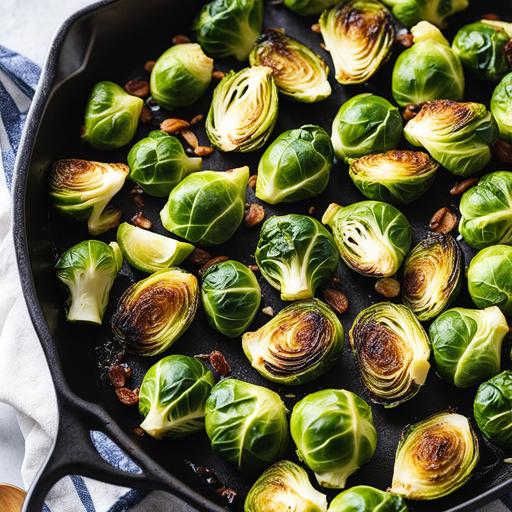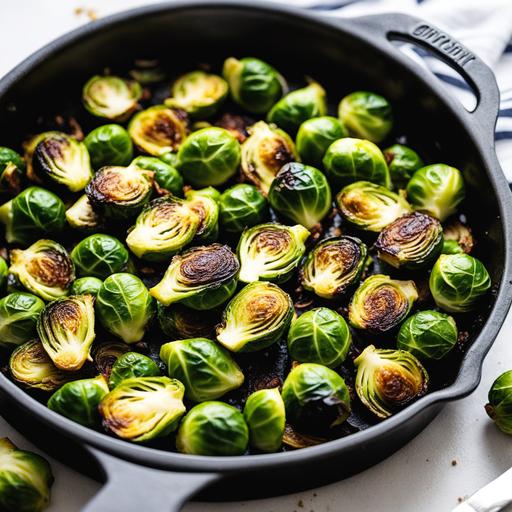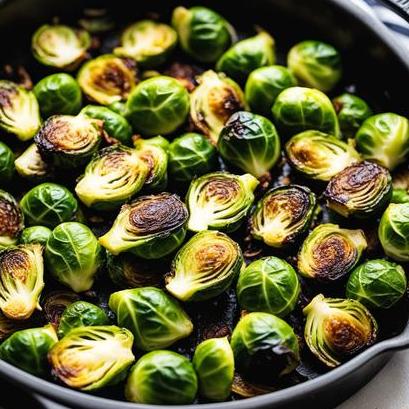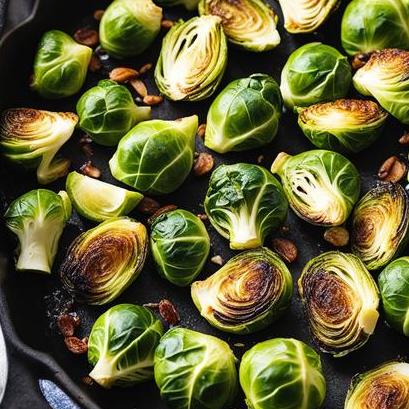
Reheat Brussel Sprouts In Oven : Step-by-Step Instructions
Brussel sprouts are a nutritious and delicious vegetable that can make a fantastic side dish or even the main component of a meal. However, if you have leftover brussel sprouts, you may be wondering about the best way to reheat them. Reheating brussel sprouts in the oven can help maintain their crispy texture and enhance their flavor. In this comprehensive guide, we will explore the best methods for reheating brussel sprouts in the oven to ensure they retain their original appeal.
Quick Answer: How To Reheat Brussel Sprouts In Oven
Reheating brussel sprouts in the oven is an excellent way to maintain their texture and flavor. Here’s a quick overview of the steps to reheat brussel sprouts in the oven:
- Preheat your oven to 350°F (175°C).
- Place the brussel sprouts in an oven-safe dish or on a baking sheet.
- Drizzle the brussel sprouts with olive oil and season with salt and pepper to taste.
- Place the dish or baking sheet in the preheated oven and reheat for 10-15 minutes, or until the brussel sprouts are heated through and crispy on the outside.
Following these simple steps can help you achieve perfectly reheated brussel sprouts with a delightful texture and flavor.
When Not To Reheat Brussel Sprouts In Oven
While reheating brussel sprouts in the oven can be an excellent way to revive their texture and taste, there are certain instances when it may not be advisable to do so. If the brussel sprouts have been sitting at room temperature for an extended period or have not been stored properly in the refrigerator, it is best to discard them rather than attempting to reheat them. Additionally, if the brussel sprouts were initially overcooked or were not thoroughly cooked, reheating them may not yield desirable results. In such cases, it’s best to prepare fresh brussel sprouts rather than trying to salvage poorly cooked leftovers.
Furthermore, if the brussel sprouts were originally coated with a sauce or dressing that does not withstand reheating, it may be better to enjoy them cold or at room temperature rather than risking a compromised flavor and texture. It’s essential to use discretion and consider the initial preparation, storage conditions, and overall quality of the brussel sprouts before deciding to reheat them in the oven.
Best Temperature To Reheat Brussel Sprouts In Oven

Selecting the appropriate temperature is crucial when reheating brussel sprouts in the oven, as it affects the overall texture and flavor of the dish. The best temperature for reheating brussel sprouts in the oven is around 350°F (175°C). This temperature is ideal for gently warming the brussel sprouts without overcooking them or causing them to become too crispy. It allows the sprouts to heat through evenly while retaining their desirable texture.
A moderate oven temperature also gives the sprouts enough time to heat through and develop a crispy exterior without burning or becoming overly charred. It’s essential to avoid high temperatures, as they can quickly dry out the brussel sprouts and result in a tough, unappetizing texture. Conversely, very low temperatures may not effectively reheat the sprouts, leading to uneven heating and a lukewarm final result. Therefore, 350°F (175°C) provides the optimal balance for reheating brussel sprouts in the oven.
Best Cooking Time To Reheat Brussel Sprouts In Oven
Determining the ideal cooking time is vital to successfully reheating brussel sprouts in the oven. In general, reheating brussel sprouts at 350°F (175°C) requires approximately 10-15 minutes. However, the specific cooking time may vary based on factors such as the quantity of brussel sprouts being reheated, their initial temperature, and the oven’s heating efficiency.
For smaller quantities of brussel sprouts, such as a single serving, a shorter cooking time towards the 10-minute mark may be sufficient to ensure they are adequately reheated. On the other hand, larger quantities or thicker cuts of brussel sprouts may require closer to 15 minutes to heat through evenly.
It’s crucial to keep an eye on the brussel sprouts while they are reheating, checking for signs of sizzling or browning around the edges, which indicate that they are nearing completion. Additionally, the desired level of crispiness can be a factor in determining the optimal cooking time. If a more substantial crisp is desired, an additional 5 minutes may be necessary.
Ultimately, the best approach is to use the initial cooking time as a baseline and monitor the brussel sprouts closely to achieve the desired level of reheating. By observing the sprouts’ appearance and texture, you can ensure that they are perfectly reheated and ready to serve.
Reheating brussel sprouts in the oven can be a convenient way to revive leftover sprouts and enjoy them with their original flavor and texture. By following the recommended temperature and cooking time, you can achieve evenly reheated brussel sprouts with a delightful crispiness. However, it’s essential to exercise caution and consider the quality and storage conditions of the brussel sprouts before reheating them. With the right approach, reheating brussel sprouts in the oven can result in a flavorful and satisfying dish that is as enjoyable as when it was freshly prepared.
How To Reheat Brussel Sprouts In The Oven
Brussel sprouts are a versatile and nutritious vegetable that can be enjoyed in many different ways. Whether they’re roasted, steamed, or sautéed, Brussel sprouts offer a unique flavor and texture that can be the star of any meal. However, there are times when we have leftover Brussel sprouts and want to enjoy them again. One of the best ways to reheat Brussel sprouts is in the oven.
Reheating Brussel sprouts in the oven is a straightforward process that will give you the perfect balance of crispiness and tenderness. Here’s a step-by-step guide on how to do it:
-
Preheat your oven to 350°F (175°C). It’s important to preheat the oven so that the Brussel sprouts cook evenly and retain their flavor and texture.
-
Take your leftover Brussel sprouts and spread them out on a baking sheet. Make sure they’re in a single layer, with some space between each sprout. This will allow them to heat up evenly and prevent them from becoming soggy.
-
If your Brussel sprouts are already seasoned or cooked with oil, there’s no need to add more. However, if they are plain or lack flavor, you can drizzle some olive oil over them and sprinkle some salt and pepper for added taste.
-
Once the oven is preheated, place the baking sheet with the Brussel sprouts in the middle rack. Allow them to heat for about 10-15 minutes. Keep a close eye on them to ensure they don’t burn or become overcooked.
-
After the 10-15 minutes mark, check the Brussel sprouts to see if they’re heated through. You can use a fork to poke them and check their tenderness. If they’re not heated to your desired temperature, continue to heat them for a few more minutes.
-
Once they’re reheated to your liking, remove the baking sheet from the oven. Let the Brussel sprouts cool for a couple of minutes before serving.
-
Serve the reheated Brussel sprouts as a side dish or add them to your favorite recipes. They can be enjoyed on their own or as part of a larger meal.
Should I Reheat Brussel Sprouts In The Oven?

When it comes to reheating Brussel sprouts, there are several methods you can choose from. However, reheating them in the oven has its own advantages that make it a popular choice among many.
One of the reasons to choose reheating Brussel sprouts in the oven is that it allows for even heating throughout, resulting in a more consistent and satisfying texture. The oven’s dry heat helps to retain the sprouts’ original crispiness and tenderness, unlike using a microwave or stovetop methods that can make them mushy or soggy.
Another advantage of reheating Brussel sprouts in the oven is that it allows for customization. You can adjust the seasonings and oil used during reheating to enhance the flavor of the sprouts. This level of control is not possible with other reheating methods.
Furthermore, reheating Brussel sprouts in the oven is also a great option when you have a larger quantity to reheat. The oven can accommodate a baking sheet with a significant number of Brussel sprouts, making it an efficient choice for meal prep or leftovers.
Best Ways To Reheat Brussel Sprouts
While reheating Brussel sprouts in the oven is a preferred method, there are a few techniques that can further enhance the flavor and texture. Here are some of the best ways to reheat Brussel sprouts in the oven:
1. Roasting Method
The roasting method is a popular choice for reheating Brussel sprouts as it adds an extra layer of crispiness. Here’s how to do it:
-
Follow the steps outlined earlier in the "How to Reheat Brussel Sprouts in the Oven" section.
-
Once your Brussel sprouts are heated through, increase the oven temperature to 425°F (220°C).
-
Allow the sprouts to roast for an additional 5-10 minutes, or until they develop a golden brown color and a slightly crispy exterior.
-
Remove the baking sheet from the oven and let the Brussel sprouts cool for a couple of minutes before serving.
The roasting method adds a delightful crunch to the reheated Brussel sprouts and enhances their natural flavors. It’s a great option for those who prefer a more caramelized and crispy texture.
2. Parmesan Crust
If you’re looking for a way to elevate the flavor of your reheated Brussel sprouts, adding a Parmesan crust is an excellent choice. Here’s how to do it:
-
Start by reheating the Brussel sprouts as explained in the "How to Reheat Brussel Sprouts in the Oven" section.
-
Once the sprouts are heated through, remove the baking sheet from the oven.
-
Sprinkle a generous amount of grated Parmesan cheese over the top of the Brussel sprouts.
-
Return the baking sheet to the oven and broil on high heat for 1-2 minutes, or until the Parmesan cheese is melted and crispy.
-
Remove from the oven and let it cool for a few minutes before serving.
The Parmesan crust adds a delicious cheesy flavor and a crunchy texture to the reheated Brussel sprouts, making them even more enjoyable.
3. Balsamic Glaze
For those who enjoy a tangy and sweet twist, adding a balsamic glaze to the reheated Brussel sprouts is a fantastic option. Here’s how to do it:
-
Reheat the Brussel sprouts using the standard method detailed earlier.
-
While the sprouts are reheating, prepare the balsamic glaze by combining 1/4 cup balsamic vinegar and 1 tablespoon honey in a small saucepan.
-
Bring the mixture to a simmer over medium heat, stirring occasionally. Allow it to simmer for about 5 minutes, or until the glaze has thickened slightly.
-
Once the Brussel sprouts are heated through, remove the baking sheet from the oven and drizzle the balsamic glaze over the top.
-
Return the baking sheet to the oven and broil on high heat for 1-2 minutes, or until the glaze starts to caramelize.
-
Remove from the oven and let it cool for a few minutes before serving.
The balsamic glaze adds a delightful tanginess and sweetness to the reheated Brussel sprouts, transforming them into a gourmet dish.
What Reheating In The Oven Does To The Brussel Sprouts
Reheating Brussel sprouts in the oven has a unique effect on their texture and flavor. While other reheating methods may result in a mushy or soggy outcome, the oven method helps to retain the original qualities of the sprouts.
When you reheat them in the oven, the dry heat helps to maintain the crispiness of the outer layers while ensuring the tender and cooked texture on the inside. The oven’s even heat distribution ensures that each sprout is heated uniformly, resulting in a consistent flavor and texture throughout.
Furthermore, the oven’s dry heat also allows you to add additional flavors and customize the seasoning to suit your preference. Whether it’s a sprinkle of salt and pepper, a Parmesan crust, or a balsamic glaze, these additional elements can transform the reheated Brussel sprouts into a delicious and exciting dish.
Reheating Brussel sprouts in the oven is an excellent option to revive leftover sprouts while maintaining their original taste and texture. By following the step-by-step guide outlined in this article, you can enjoy perfectly reheated Brussel sprouts with just the right amount of crispiness and tenderness. Moreover, the oven method provides several advantages over other reheating methods. It offers an even heat distribution throughout the sprouts, allows for customization of flavors and seasonings, and is suitable for heating larger quantities. Additionally, there are various ways to enhance the reheated Brussel sprouts, such as the roasting method, adding a Parmesan crust, or drizzling them with a balsamic glaze. Next time you find yourself with leftover Brussel sprouts, consider reheating them in the oven for a delightful and satisfying meal.
Can You Restore The Initial Quality Of Brussels Sprouts?

If you have some leftover Brussels sprouts and you’re wondering how to reheat them to maintain their taste, texture, and nutritional value, the oven can be a great option. Reheating Brussels sprouts in the oven can help restore their initial quality, making them just as delicious as when they were freshly cooked.
Brussels sprouts are a nutritious and versatile vegetable that can be enjoyed as a side dish or a main course. When reheating Brussels sprouts, the goal is to restore their original flavor, texture, and nutritional value as much as possible. While reheating may slightly alter the texture, it is still possible to reclaim the deliciousness of Brussels sprouts by using the oven method properly.
The oven method helps to maintain the crispy exterior and tender interior of Brussels sprouts, while also ensuring even heating throughout. It avoids excessive moisture loss or sogginess that can occur with other reheating methods such as microwaving. By following some tips and guidelines, you can achieve the best results when reheating Brussels sprouts in the oven.
Tips For Optimal Reheating Results
-
Preheat the oven: Before placing the Brussels sprouts in the oven, make sure to preheat it to the desired temperature. This allows for even heat distribution and ensures that the sprouts are thoroughly reheated.
-
Slice or halve the Brussels sprouts: If the Brussels sprouts are whole, consider slicing them in half or quarters before reheating. Smaller pieces will heat more evenly and prevent some parts from becoming overcooked while others remain undercooked.
-
Toss with oil and seasonings: To enhance the flavor and prevent dryness, toss the Brussels sprouts in a little oil (such as olive oil) and your preferred seasonings before reheating. This will help them to retain moisture and develop a delicious crispy exterior.
-
Spread them out in a single layer: Arrange the Brussels sprouts in a single layer on a baking sheet or oven-safe dish. This ensures that each sprout receives the same amount of heat and promotes even cooking.
-
Cover with foil or a lid: If you find that the Brussels sprouts are becoming too crispy or dry during reheating, cover them with foil or place a lid over the baking dish. This will help to retain moisture and prevent the sprouts from becoming overly browned.
-
Reheat at a moderate temperature: Set the oven to a moderate temperature, around 350°F (175°C), for reheating Brussels sprouts. This temperature allows for thorough reheating without causing any burning or excessive browning.
-
Monitor the reheating process: Keep an eye on the Brussels sprouts while they are reheating in the oven. This will help prevent them from burning or overcooking. Stir them gently every few minutes to ensure even heating and avoid any potential hotspots in the oven.
-
Check for doneness: To determine if the Brussels sprouts are properly reheated, you can test them with a fork or toothpick. They should be tender and easy to pierce. The internal temperature should reach at least 165°F (74°C) to ensure they are safe to eat.
Reheat Brussels Sprouts More Than Once?
While it is generally safe to reheat leftovers, including Brussels sprouts, it is advisable to only reheat them once. Repeated reheating can lead to a loss of flavor, texture, and nutritional value. Additionally, each reheating cycle poses a potential risk for bacterial growth, particularly if the Brussels sprouts have been left at room temperature for an extended period.
To ensure food safety and minimize the risk of foodborne illnesses, it is best to reheat Brussels sprouts only when you are ready to consume them. It is not recommended to reheat them, refrigerate, and then reheat them again later. If you have leftovers, store them in an airtight container in the refrigerator and consume them within 2-3 days.
Safety Measures When Reheating Brussels Sprouts

When reheating Brussels sprouts, it is important to follow some safety measures to minimize the risk of foodborne illnesses and ensure that the sprouts are safe to consume. These measures include:
-
Proper storage: Store leftover Brussels sprouts in an airtight container in the refrigerator within two hours of cooking. This prevents the growth of bacteria and keeps the sprouts fresh.
-
Thorough reheating: Ensure that the Brussels sprouts are heated to an internal temperature of at least 165°F (74°C) to destroy any potential bacteria or microorganisms that may have grown during storage.
-
Use clean utensils: When handling Brussels sprouts, make sure to use clean utensils and avoid cross-contamination with other foods. This helps prevent the transfer of harmful bacteria.
-
Avoid reheating in large quantities: When reheating Brussels sprouts in the oven, it is better to reheat smaller portions at a time rather than reheating a large batch. Heating smaller quantities ensures more even reheating and reduces the risk of unevenly heated or undercooked sprouts.
-
Discard if in doubt: If you are uncertain about the freshness or safety of the reheated Brussels sprouts, it is best to err on the side of caution and discard them. Consuming spoiled or unsafe food can lead to food poisoning.
By following these safety measures, you can enjoy reheated Brussels sprouts without compromising your health.
Reheating Brussels sprouts in the oven can help restore their initial quality, flavor, and texture. By following the tips provided, such as preheating the oven, tossing them in oil and seasonings, and reheating at a moderate temperature, you can achieve optimal results. However, it is important to note that reheating Brussels sprouts more than once is not recommended. Each reheating cycle increases the risk of bacterial growth and can lead to a loss of quality. Proper storage, thorough reheating, and adhering to safety measures are essential to ensure the reheated Brussels sprouts are safe to consume. With these guidelines in mind, you can enjoy delicious reheated Brussels sprouts without compromising your health.
Adjusting Reheating Times
Brussels sprouts are a great addition to any meal and offer a plethora of nutrients that are essential for the body. However, when it comes to reheating Brussels sprouts, it can be a challenge to maintain the same level of taste, texture, and aroma as the freshly cooked ones. Reheating Brussels sprouts in the oven can help you achieve similar results as cooking them for the first time.
The ideal time required for reheating Brussels sprouts in the oven depends on various factors like the quantity, freshness, and the temperature at which they were stored. It is essential to adjust the reheating time according to these factors to achieve optimal results.
When reheating Brussels sprouts in the oven, preheat the oven to 400°F/200°C. Spread the sprouts in a single layer on a baking sheet. Heat them for around 8 to 10 minutes or until they are heated through and slightly crispy. Make sure the Brussels sprouts are heated evenly by stirring them in between.
If you are reheating a larger quantity, you may need to increase the reheating time and divide the sprouts into smaller batches to ensure even heating. It is better to use an oven thermometer to check the internal temperature of the sprouts. The internal temperature should be 165°F to ensure that they are safe to eat.
Avoiding Common Mistakes In Oven Reheating
Reheating Brussels sprouts in the oven can be a challenge, and there are some common mistakes that people tend to make. Here are some of the common mistakes that you should avoid.
Overheating
Overheating the Brussels sprouts can result in burning and charring, which will affect their texture and taste. It is essential to avoid overheating and stick to the recommended reheating times.
Not Spreading The Sprouts Evenly
To get evenly reheated sprouts, make sure you spread them in a single layer on the baking sheet. Overcrowding the baking sheet can lead to uneven heating.
Not Storing Them Properly
It is essential to store the Brussels sprouts in an airtight container in the refrigerator to maintain their freshness. If they are not stored correctly, they can become dry and tough, making them challenging to reheat.
Using The Wrong Temperature
Using the wrong temperature can affect the texture and taste of the Brussels sprouts. It is essential to follow the recommended temperature and reheating times.
Tips And Tricks To Reheating Brussel Sprouts In Oven
Here are some tips and tricks that can help you achieve the best results when reheating Brussels sprouts in the oven.
Add Some Oil
Adding some oil to the Brussels sprouts before reheating can help to retain their moisture. It can also help to prevent them from becoming dry and tough.
Add Some Seasonings
Adding some seasonings like salt, pepper, and garlic powder can enhance the taste of the Brussels sprouts and give them a new flavor. You can also try different herbs and spices like rosemary, thyme, or paprika, according to your preference.
Steam Them Before Reheating
If the Brussels sprouts are too dry, you can try steaming them before reheating. This will help to retain their moisture and prevent them from becoming tough.
Add Some Cheese
Adding some cheese like parmesan or cheddar can add a unique flavor to the Brussels sprouts and make them more appetizing. To do this, sprinkle some cheese over the sprouts during the last few minutes of reheating.
Use Aluminum Foil
Covering the Brussels sprouts with aluminum foil during reheating can help to retain their moisture and prevent them from drying out. Remove the aluminum foil during the last few minutes of reheating to get a crispy texture.
Conclusion
Reheating Brussels sprouts in the oven can be a great alternative to cooking them again from scratch. However, it is essential to follow the correct reheating times and avoid common mistakes to achieve optimal results. With the tips and tricks provided in this article, you can enjoy the same delicious Brussels sprouts even after reheating.
FAQS
How Do You Reheat Brussel Sprouts In The Oven?
Preheat your oven to 375°F (190°C). Spread the brussel sprouts in a single layer on a baking sheet and drizzle with olive oil. Bake for 10-15 minutes, or until heated through.
Can You Reheat Brussel Sprouts That Have Already Been Cooked In Oil?
Yes, you can reheat brussel sprouts that have been cooked in oil. Make sure to drain them well before reheating to prevent them from becoming too greasy.
How Long Do You Reheat Brussel Sprouts In The Oven?
The length of time to reheat brussel sprouts in the oven varies depending on the quantity and size of the sprouts. Generally, it takes about 10-15 minutes to reheat them at 375°F (190°C).
Can You Reheat Brussel Sprouts In The Oven From Frozen?
Yes, you can reheat frozen brussel sprouts in the oven. Preheat your oven to 375°F (190°C) and spread the frozen sprouts in a single layer on a baking sheet. Bake for 20-25 minutes, or until heated through.
How Do You Prevent Brussel Sprouts From Becoming Too Dry When Reheating Them In The Oven?
To prevent brussel sprouts from becoming too dry when reheating them in the oven, you can add a small amount of water or broth to the baking dish before placing it in the oven. You can also cover the dish with aluminum foil to trap moisture and prevent the sprouts from drying out.


